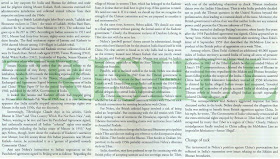The first two consecutive test-firings in lofted top-attack mode of the definitive version of the third-generation HELINA anti-armour
guided-missile on July 15 and 16 at the DRDO’s ITR at Balasore has finally
kicked off the process of integrating the missile with the ‘Dhruvastra’ weapons-control
systems on-board the Rudra WSI (Dhruva Mk.4) helicopter-gunships (78 for the
Indian Army Aviation Corps or AAC, distributed among 7 Squadrons, and 16 for
the Indian Air Force or IAF) and Light Combat Helicopter or LCH (97 for the AAC and 65 for the IAF).

The 7km-range HELINA’s
developmental effort began back in 2012 after it was discovered that the 4km-range
NAG anti-armour guided-missile will not be suitable (from a flight-safety
standpoint) in a helicopter-launched configuration. In the initial round of
test-firings in late 2016 and mid-2017, the HELINA’s imaging infra-red (IIR) seeker,
which was derived from that of the NAG failed to acquire and engage ground-based
moving and stationary targets beyond a range of 5km.
This led to the IIR seeker’s
sensitivity being subjected to further improvements aimed at achieving mission
effectiveness out to the specified range of 7km during both daytime and at
night.
A series of user-assisted
firing trials lasting eight months will kick off by the year’s end for
validating the HELINA/Dhruvastra combination’s performance during both
winter-time and summer-time over different kinds of terrain and at different
operating altitudes. Following this, by late 2021 the Rudras and LCHs will
start receiving the series-production HELINA/Dhruvastra combinations.
It may be recalled that the first
Rudra prototype made its maiden flight in August 2007. After a series of flight
and weapons trials lasting almost six years, the 5.5-tonne Rudra achieved Initial
Operational Clearance (IOC) in February 2013. The first two Rudras were
officially handed over to the AAC during the Aero India 2013 expo at Yelahanka,
Bengaluru. Since then, it has taken almost another eight years for the Rudra to
emerge as a fully weaponised helicopter-gunship for delivering immediate air-support
to the Indian Army.




The 5.8-tonne LCH’s
development began at HAL’s RWR & DC Division way back on October
3, 2006 when the Ministry of Defence (MoD) sanctioned a sum of Rs.376.67 crores
for HAL to design and develop the LCH over a 24-month period. Powered by twin
Ardiden 1H (1,200shp TM333-2C2 Shakti) engines, the first LCH
prototype—TD-1—completed its first ground-run on February 4, 2010 and its
maiden flight was logged on March 29, 2010. Exactly a year later, the IAF
placed a production indent with HAL for procuring 65 LCHs, including 10 LSP
models. Three months later, the LCH’s second prototype, TD-2, made
its maiden flight on June 28, 2011. The third prototype—TD-3—made
its maiden flight on November 12, 2014, while the fourth and last
prototype—TD-4—took to the skies on December 1, 2015.

The LCH was originally targetted
in 2006 to achieve its IOC by 2013, but as of now, it has yet to complete
its weapons-firing trials (due to delayed availability of the HELINA), while its
self-protection sensor suite (comprising radar warning receivers, laser warning
receivers and missile approach warning system) has yet to be integrated with
the airframe. IOC attainment now is not expected before the end of 2021.
It is also expected that the
IA, which has to date ordered 443 Bharat Dynamics Ltd-built third-generation
NAGs along with 13 OFB Medak-built NAMICA-2 tracked missile launchers, will
decide against ordering additional NAGs and will instead opt for the longer-range HELINA for
its follow-on NAMICAs.
Also under development is a
DRDO-developed fire-and-forget millimetre-wave (MMW) W-band seeker for a 12km-range
version of the HELINA, called SANT. However, the R & D cycle of this missile
is unlikely to be completed by 2021 at the very latest.
Total orders for the HELINA
for both the IA and IAF are expected to exceed 8,500 units, while for the SANT
the requirement is for 4,000 units.
Airborne SDR-Based Tactical Data-Links For MRCAs & Attack Helicopters
RAFAEL-developed BNET-AR will
be installed on the Tejas Mk.1As, MiG-29UPGs, Rudras (for CSAR) and LCHs of the
IAF, while the IN has already begun installing them on its MiG-29Ks and
upgraded Ka-28PLs.
The THALES-developed data-link (below) is for the Rafale M-MMRCA.
From 57mm To 68mm To 80mm & Now To 70mm Unguided Rockets
The IAF began using unguided air-to-surface rockets with the Dassault Mysteres. The MATRA-built Type-155 rocket pod was used for firing the 68mm SNEB (Societe Nouvelle des Etablissements Edgar Brandt) developed by the French company TDA Armements, which in turn allowed the MoD-owned Ordnance Factory Board (OFB) to licence-build them. However, attempts to use such rockets by the Hawker Hunter and Folland Gnat/HAL Ajeet proved unsuccessful.
The MATRA Type-115/SNEB combination was subsequently
used also by the HAL HJT-16 Kiran basic jet trainers, SEPECAT/HAL Jaguar IS
interdictor/strike aircraft, BAE Systems Sea Harriers of the Indian Navy, and
Dassault Mirage-2000s of the IAF.
For aircraft and helicopters like the MiG-21FL, Su-7BM, MiG-23BN, MiG-27M, Mi-4, Mi-17, Mi-25 and Mi-35P, the IAF began using the UB-16 and UB-32 rocket pods for firing 57mm rockets, and this was followed since the mid-1980s by the usage of 80mm B-8M1 rocket pods, which are now in use by the Mi-17V-5s, Mi-35Ps and MiG-29UPGs of the IAF, and the MiG-29Ks of the Indian Navy.
For
the Rudra WSI and LCH, Belgium-based Forges de
Zeebrugge (now known as THALES
Belgium) is supplying the FZ231 lightweight composite material,
high-drag, straight cylindrical 12-tube reusable launcher that is is equipped
with removable universal dual-purpose FZ125 detent mechanism that enables the
firing of 70mm Mk.40 and FZ-90 FFAR and WA rockets. The FZ231 is also equipped
with a LIU interface (Launcher Interface Unit).
The IAF’s 22 Boeing AH-64E
Apache attack helicopters use the 70mm Hydra-70 rockets that are fired from the 19-tube
LAU-61 launcher. Both are produced by General Dynamics Armament and Technical
Products (GDATP).
























































